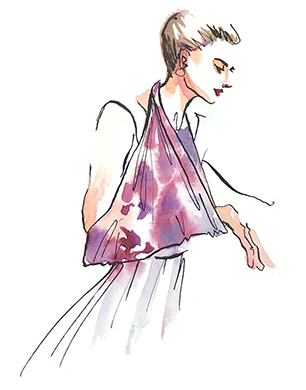 Do you have a soft spot for silk? You’re not alone. Gorgeously versatile, this is a fabric that seems to effortlessly make its way into every style niche, from haute couture and eveningwear to loungewear and street style.
Do you have a soft spot for silk? You’re not alone. Gorgeously versatile, this is a fabric that seems to effortlessly make its way into every style niche, from haute couture and eveningwear to loungewear and street style.
The secret behind this indulgent material’s diversity is almost certainly woven into the long history of silk in fashion. Thousands of years of history and fashion references are intertwined in every length of silk. With archaeological evidence indicating that silk was cultivated in China as early as 4000BC, humans have enjoyed a very, very long love affair with this elegant, sensual material.
The Fashionable History of Silk
The silken goddess
Although a silk cocoon that was cut with a knife was found dating to the fourth millennium BC, the legendary origins of silk tell a much more romantic story. In Chinese lore, Lady Hsi Ling Shih was said to be the Goddess of Silk. This ancient empress is believed to have lived between 2700-2600BC. The wife of Huang Ti, the Yellow Emperor, this royal lady is credited with discovering silk while enjoying a cup of tea in her palace gardens.
Seated beneath a mulberry tree, Lady Hsi Ling Shih was startled when a silkworm cocoon fell into her cup from the branches above. She was even more amazed when she watched the delicate threads of the cocoon unravel in her tea. As she looked closer, she saw that each gossamer thread had a shimmering sheen.
Captivated, the empress set out to learn more about the cocoon, tracing it back to the Bombyx mori silkworms residing in the mulberry trees that ornamented the palace gardens. She soon discovered how to nurture these worms and harvest their silk (a practice now called ‘sericulture’). She built looms to weave each silky strand into one length of soft, gleaming material.
Although unlikely to be entirely true, the romance of this mythical discovery is hard to resist. It also begins the long tradition of silk-wearing among prestigious, regal and wealthy figures throughout history.
Royalty and conquerors
Over many centuries, silk spread into Europe and West Asia, travelling along the famous Silk Road, along with prized spices and ingredients. From ancient Persia to the Roman Empire, silk became a coveted material, clothing figures including King Darius III, whose Persian court had a penchant for silk head wraps that wound around the hair and neck.
Meanwhile, in Korea around 600AD, Queen Seondeok of Silla (the first woman to reign over one of Korea’s three kingdoms) learned to tend silkworms as a young girl. When she became queen, long silk robes with billowing, wide sleeves were the fashion at her court. Each official wore silk sleeves in a colour that signified their aristocratic role.
The Roman Emperor Caligula also adored silk. Ancient historians write of his extravagant and scandalous lifestyle, which included clothing himself in draped silken robes in order to emulate Roman goddesses such as Juno and Diana. The Roman Emperor Elagabalus was yet another silk aficionado. This decadent emperor wore a new silk garment every day, believing that wearing washed clothes was for common peasants.
Starlets and socialites
Over time, silk became more accessible to less regal wearers. Indian socialite Indira Devi popularised the still iconic silk sari in the late 1800s. This fashionable woman was often the talk of the nation, thanks to her famous love match with the maharaja of Cooch Behar at a time when love matches were rare in India.
When the great age of cinema began, silk could be seen bedecking some of the silver screen’s more iconic stars. Grace Kelly once created a chic sling for her broken arm made from a Hermes silk scarf. Audrey Hepburn, meanwhile, made silk scarves an enduringly chic fashion moment, which has been emulated for decades.
Today silk is still synonymous with elegance and luxury, but it is also more obtainable for everyday wear. No longer reserved for ‘special occasionwear’, staples such as the sleek silk shirt are now a key ingredient in chic workwear wardrobes. With centuries of silk history to draw inspiration from, this pearlescent fabric is now embraced across the style spectrum, inevitably bringing a touch of natural sophistication to each distinct look.

